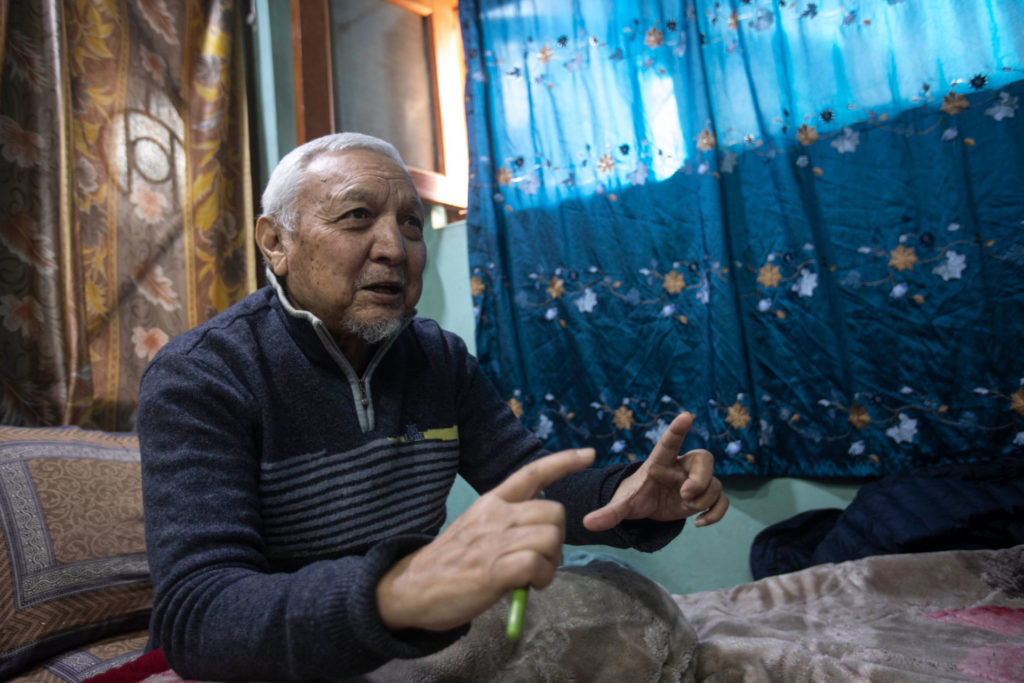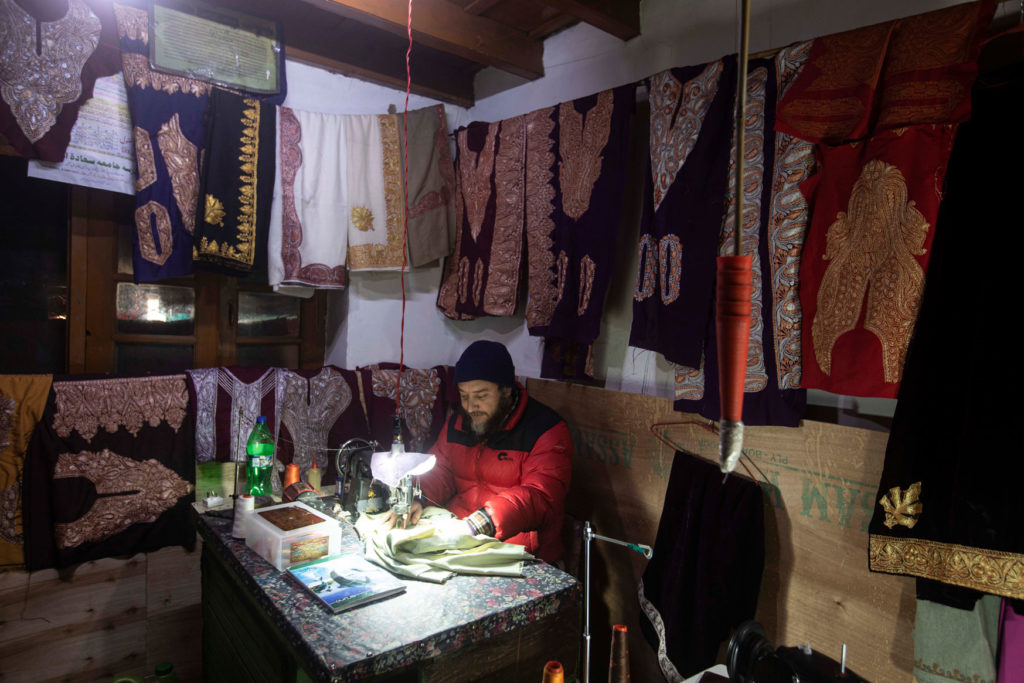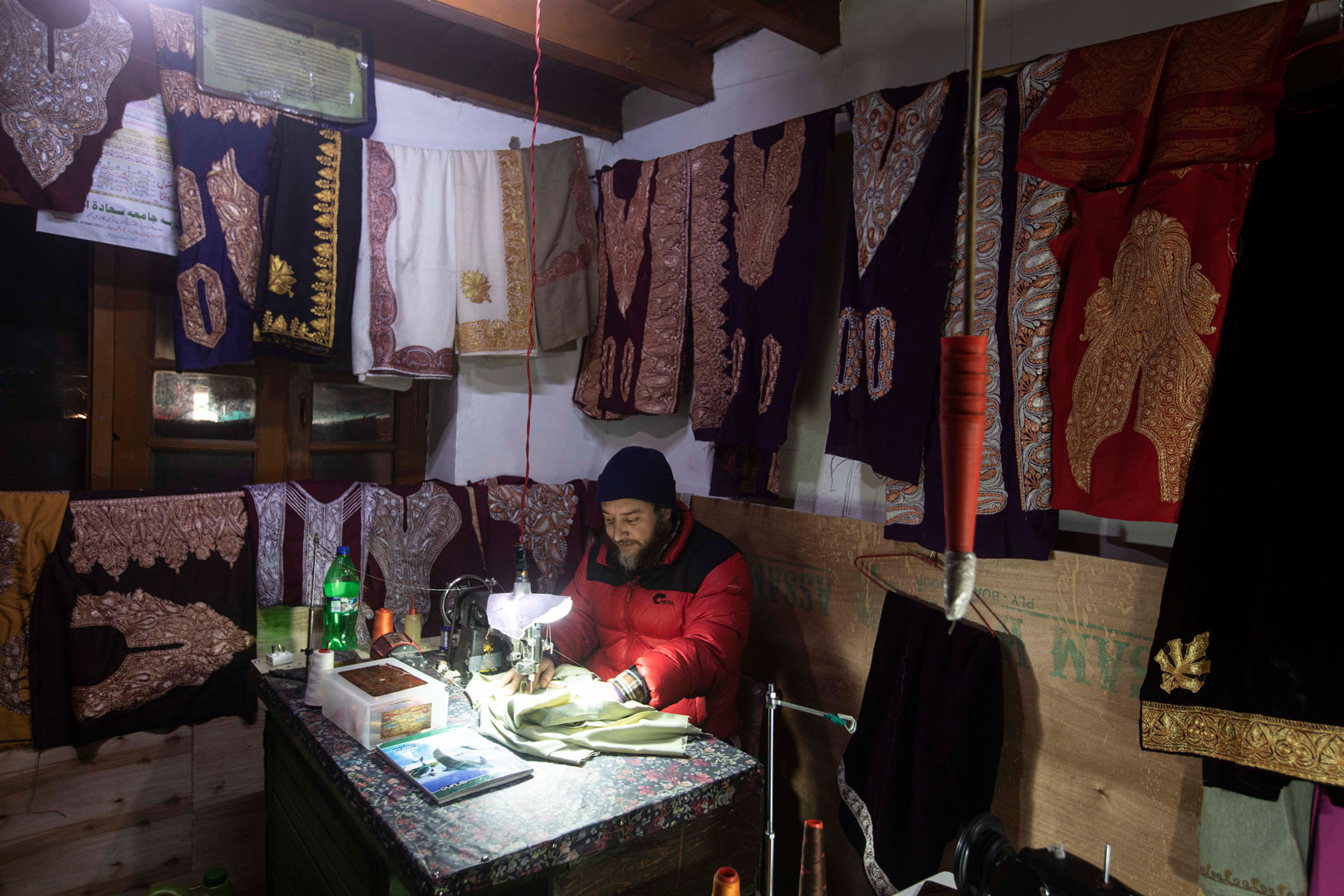In Tibet, they were called “Khache,” a word for Kashmiri. In Kashmir itself, they are called “Tipti,” or Tibetan. This distinct community of Tibetan Kashmiris has been living quietly on the foothills of a small hillock on the outskirts of Srinagar’s downtown area in the Himalayan region of Jammu and Kashmir for over six decades.
Faizullah Malik, a Tibetan Muslim, was playing on the streets of Lhasa, the capital of Tibet, when Chinese troops took control of the city after a failed uprising against Beijing by the Tibetans in 1959. Age 10 at the time, he was too young to understand the sequence of events unfolding before him. A Buddhist country, Tibet was considered the most spiritual place in the world. In Lhasa, the home of the Dalai Lama, people were known to spend much of their time in meditation, aiming to achieve salvation.
Lying on the bed in his two-story house in Srinagar, the capital of Jammu and Kashmir, Malik, now 73, was watching the news on TV, curious to know the election results in India’s highly polarized state of Uttar Pradesh, when he lowered the volume and turned to me to narrate the Tibetan Muslims’ journey from Lhasa to Kashmir. He is one of the few who still have memories of their time in Tibet; most of the others are now dead.
“The country (Tibet) was (steeped) in rich tradition and cultural values. It was a civilized society where everyone was welcomed irrespective of their religious beliefs,” Malik said. His family was among the 130 families that used to travel to Tibet from the Kashmir and Ladakh regions for years to trade before settling down in the country permanently. “There is a misconception that we migrated only once from Tibet to Kashmir. The truth is we are Kashmiris whose ancestors used to travel to Tibet via the silk route,” he said.

Though nobody knows exactly when the community settled in Tibet, Malik said it was the 13th Dalai Lama, Thubten Gyatso, who granted the families a piece of land to build houses and continue with their businesses in the region. He held office from the late 1800s until his death in 1933. “Over the years, our ancestors married Tibetan women, learned the Tibetan language and became a distinct community in Lhasa. There was no restriction on practicing our religion. We were allowed to build our own mosque and carry out our business without any hindrance,” he said.
While most superpowers embarked on decolonization after World War II ended in 1945 — three dozen new states in Asia and Africa achieved independence from their European colonial rulers in that era — China was expanding its empire in Central Asia by tightening its grip over Tibet. Relations had already started to deteriorate when the 13th Dalai Lama declared Tibet’s independence following the fall of the Qing Dynasty in 1912, and the territory adopted its own national flag, currency, stamps, passports and army. China, however, rejected the declaration of independence and sent its troops into Tibet in 1950, in what came to be known as the Battle of Chamdo, overthrowing the government that had ruled the autonomous region for nearly 40 years.
On May 23, 1951, under Chinese pressure, the Tibetan government accepted a 17-point agreement that included “returning to the motherland, the People’s Republic of China (PRC).” Yet the agreement was not well-received by the United States, which was actively invested in the conflict. Washington asked the 14th and current Dalai Lama, Tenzin Gyatso, to publicly disavow the agreement, claiming it was made “under duress,” in order to receive U.S. assistance and support. The agreement was eventually nullified by the Tibetan exile community after the Dalai Lama fled the country in 1959.
However, Tibetans continued to raise their voice against Chinese repression. The Dalai Lama was involved in diplomatic talks with India and other countries to peacefully resolve the issue. In 1956, Tibetans rebelled against the Chinese authorities in the Qamdo and Sichuan provinces of Tibet. That same year, the U.N. General Assembly passed a resolution calling for the end of Chinese repression against the Tibetans. In 1958, Tibetans started to revolt in eastern Tibet. In 1959, they began the rebellion in Lhasa, which eventually led to the Dalai Lama’s exile.
On March 10, 1959, a revolt erupted in Tibet’s capital after rumors spread of the Dalai Lama’s arrest. Initially, Tibetans staged peaceful protests, but things turned violent when some took up arms and rebelled against the Chinese authorities. “The People’s Liberation Army resorted to firing, which resulted in the deaths of many civilians,” Malik said. David G. Atwill, a professor of history at Penn State University, wrote in his book “Islamic Shangri-La: Inter-Asian Relations and Lhasa’s Muslim Communities, 1600 to 1960” that though the Chinese government has given no figures for the Chinese or Tibetans killed during the clashes, it is estimated that more than 4,000 rebel troops were taken prisoner.
After the failed uprising against Chinese rule in March 1959, many Tibetans, including the Dalai Lama, fled the region and took asylum in India. After the Dalai Lama walked for 14 days through rugged snowy terrain, India confirmed his safe entry into the country on April 4, 1959. Jawaharlal Nehru, then India’s prime minister, told the Indian Parliament that the Dalai Lama was accompanied by an entourage of 80 people, who crossed Chutangmu checkpoint, about 40 miles south of Towang in Himachal Pradesh, close to the eastern border of Bhutan, where he was received by an assistant political officer.
Nehru not only allowed Tibetans to take asylum in India but also facilitated the formation of their government-in-exile, called the Central Tibetan Administration (CTA). All the migrants were provided stay permits, called “Registration Certificates,” which the Indian government renewed each year. Situated in Dharamshala in Himachal Pradesh, the CTA still operates as a shadow government for Tibetans living in exile around the world, particularly in India.
After the Dalai Lama’s move to India, Tibetan Muslims had to decide their future themselves. Afraid of losing religious freedom under China’s communist rule, they approached the Indian Consulate in Lhasa to facilitate their return to India. Two diplomats, S.L. Chibber and P.N. Kaul, who was India’s consul general in Lhasa at the time, played a pivotal role in facilitating their safe passage to India. “Kaul himself was a Kashmiri Pandit and knew almost all the families living in Lhasa. So he informed the Indian government about the situation, which prompted Prime Minister Nehru to write to the Chinese authorities to provide us a safe route to return to India,” said Malik.
According to official communications documented in Atwill’s book, India provided a list to the Chinese authorities of 129 Muslim families of Kashmiri origin who were then repatriated from Tibet in 1960. “All the families boarded Chinese military vehicles along with their belongings and were dropped to the [then] India-Sikkim border,” Malik recalls. “Unlike the Dalai Lama and his followers who fled the country, we [Tibetan Muslims] were repatriated,” he said.
After reaching India, the community initially camped at Kalimpong, then moved to Darjeeling in West Bengal, where they stayed for about six months. “In Kalimpong, we formed our first association headed by a wealthy merchant, Faizullah Chisti,” Malik said. Since they had roots in Kashmir and it enjoyed similar weather conditions to Tibet, the families were keen on moving to the valley. “Initially, the government of India advised us not to go to Kashmir [because of the dispute between India and Pakistan] and suggested that we either settle in Kalimpong or move to Bengaluru in southern India,” Malik explained. However, they pressed the government and almost 90% of the families moved to Kashmir. “Some traveled to Nepal, while a few of them settled in Kalimpong,” he said.
Upon reaching Kashmir, the families lived in makeshift camps in the Eidgah neighborhood of Srinagar. Later, Bakshi Ghulam Mohammad, then the prime minister of Jammu and Kashmir, constructed houses for them in the same area. Around 1975, after they had lived there for less than two decades, the chief minister at the time, Sheikh Abdullah, granted them state-owned land in the Hawal area of Srinagar, which later came to be known as the Tibetan Colony.
In addition to the land, the government also provided a loan of 6,000 rupees ($75) to each family to build houses. “In Kalimpong, we created a welfare fund which we later invested in building our homes. It was a collective effort by the government and us, and we managed to resettle in our ancestral place,” said Malik. While some of the houses that Bakshi built still exist and a handful of families live there, the majority migrated to Hawal.
Despite their ancestral roots in Kashmir, even after six decades, Tibetan Muslims cannot buy land in the region. The houses they built are on state-owned land and they lack the requisite permanent residency certificates to purchase property in the state. Article 370 of the Indian Constitution, which granted the state of Jammu and Kashmir semi-autonomous status in the early 1950s, prevents nonstate residents from buying land or applying for government jobs. Habibullah Gania, who was 2 years old when his family moved to India after the 1959 uprising, told New Lines that, although they were given the right to vote, they are still “living like refugees” in Kashmir after all these years.
However, in 2019, the Indian government abrogated Article 370, revoking the region’s semi-autonomous status, thus opening the possibility for Indian citizens and communities like the Tibetan Muslims in Kashmir, West Pakistan Refugees (WPRs), and over 5,500 Hindu and Sikh families who settled in Jammu after Partition to buy property and apply for government jobs in the state. The Indian government granted citizenship to WPRs right after the abrogation and made them permanent residents. Yet these measures did not apply to Tibetan Muslims.
“We were compelled to leave Tibet to safeguard our religious identity. Here, though we are free to practice our religion, we are made to feel unwanted at times,” said Gania, who believes life was better in Lhasa than in Kashmir. Though his family lived in rented accommodation, they had amassed wealth in Tibet and were among the richest merchants, whereas in Kashmir there are limited job or business opportunities for people like them. Government jobs are the most secure and prestigious, which is why they are coveted in Kashmir and South Asia at large.
Gania recalled how two of his cousins who went to Nepal are comfortable with tenured jobs as teachers in public schools. By contrast, in Kashmir, first-generation Tibetan Muslims are ineligible to apply for these government jobs. New Lines reached out to the Jammu and Kashmir Home Department for an update on the status of Tibetan Muslims’ permanent residency but received no response.
According to the latest data from the Center for Monitoring Indian Economy, Jammu and Kashmir has a 17% unemployment rate, the third-highest in the country. With the rise of militant insurgency in the early 1990s, few companies have been willing to establish businesses in the region. Compared to other Indian states, Kashmir lacks a thriving private sector. Apart from small businesses in such sectors as dairy, poultry and horticulture, there are limited opportunities for commerce. There is scope in tourism but this is also challenging, due to regular curfews and lockdowns.
Ineligible for government jobs or permanent residency and with a weak private sector, many youths in the community have opened embroidery shops or Tibetan food outlets. Others have moved to different parts of India, either to acquire higher education or to search for private-sector jobs.
Imtiyaz Ahmad Bhat, 38, has a Bachelor of Science degree but, due to the lack of job opportunities in the region, he has started a small embroidery shop by converting a portion of his house into a workstation. “After losing my father five years back, all the family responsibilities fell on my shoulders. So, in the absence of a suitable job, I started this shop to earn a livelihood,” he said. Now married, Bhat said he is satisfied with his earnings. But, more than that, he is content with carrying on the traditional business his ancestors left for him.

Stitched in needlepoint, using gold and silver threads, Tibetan embroidery — known locally as Bota Tilla — has become an essential part of Kashmiri attire. It is a prominent feature on the women’s cloak known traditionally as a “pheran,” worn for special occasions. “We are being credited for introducing embroidery into Kashmir. It is my family business, and I intend to continue with it,” said Bhat. There are at least four to five embroidery shops in the Tibetan colony, and customers come from across the city to get their clothes embroidered with a variety of designs.
Most of the shop owners are second-generation Tibetan Muslims, who were either too young to remember or were not born during the exodus from Tibet. Bhat’s father Ghulam Ahmad Bhat was born in Tibet and was 7 years old when the family was repatriated to India. Though Bhat has never been to Tibet, he has heard many stories from his grandparents about their time in the region. “Maybe somewhere down the line I might visit Tibet to get a firsthand experience of the tales which my elders used to narrate,” he said.
Abu-Bakar Nawajoo, 43, runs a restaurant in the Tibetan colony called Tibetan Kitchen. Also a college graduate, he worked in embroidery before his uncle set up the restaurant, which he takes care of now. The menu features traditional and popular Tibetan dishes such as “momos,” which are dumplings made of meat wrapped in flour dough; “thukpa,” a noodle soup with lean chicken; “shapale,” bread stuffed with meat and cabbage; and “chow mein,” stirred noodles with vegetables and meat. Displayed behind the billing counter is a large picture of the Potala Palace, which until 1959 was the winter palace of the Dalai Lama in Lhasa.
Nawajoo said that, initially, the cuisine’s popularity was limited to their own community but, over the years, locals have grown fond of it. In the last five to six years, many Tibetan restaurants have opened across the city. Apart from locals, tourists who visit Kashmir from other states in India also come to these restaurants to enjoy authentic Tibetan food.
However, the Tibetan community has not only brought its traditional food to the palates of Kashmiris but has also adopted local cuisine as well. “At home, we usually eat rice and drink noon chai, the salted pink tea, like a common Kashmiri. During weddings, we make sure to cook ‘wazwan,’ a multi-course Kashmiri meal, apart from our traditional food items,” Nawajoo said.
Though they have Kashmiri surnames like Trumboo, Malik, Bhat and Shah, which confirm their Kashmiri origin, they live between two cultures — Kashmiri and Tibetan. This has made them a unique community, bolstered by the fact their facial features distinguish them from other Kashmiris. Because of this, they are often at the receiving end of racial slurs. “Many call us Tipti, which makes us feel as if Kashmiri society has not accepted us as one of their own,” said Gania.
Over the years, Tibetan Muslims have maintained close ties with the CTA and the Dalai Lama. In 2004, the community established a school in the vicinity of the Tibetan colony, which was partially funded by the CTA and is looked after by the Central Tibetan Schools Administration (CTSA). Established in 1961 as a society by the government of India, the objective of the CTSA was to establish, manage and assist schools for the education of migrant Tibetan children living in India while preserving and promoting their culture and heritage. Currently, the CTSA runs 55 schools in India.
While the school in Srinagar is managed exclusively by Tibetan Muslims, it is open for all. The school’s principal, Abida Ali, said that 755 students are currently enrolled up to the 10th grade. In 2012, on his maiden visit to Kashmir, the Dalai Lama met the Tibetan Muslims living in the valley, visited the school and interacted with the students. In 2014, when Kashmir witnessed devastating floods resulting in the deaths of 300 people, the CTA donated funds and assistance to victims. In 2018, over 15 students traveled to Dharamshala in Himachal Pradesh and met with the CTA president, Dr. Lobsang Sangay, at Kashag, the Tibetan secretariat, said the secretary of the school management body, Irfan Butt.
Inayatullah Malik, a former principal of the school, has fond childhood memories in Tibet. “I still desire to visit the place where I was born, before I die,” he said.



